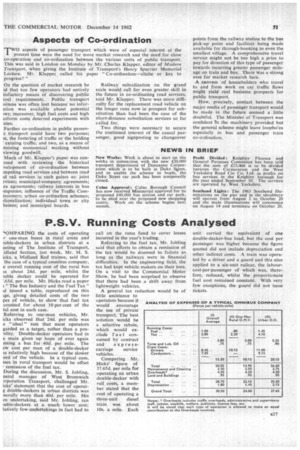P.S.V. Running Costs Analysed
Page 53

If you've noticed an error in this article please click here to report it so we can fix it.
' OMPARING the costs of operating
one-man buses in rural areas and mble-deckers in urban districts at a eeting of The Institute of Transport, idland Section, last week, Mr. M. S. icks, a Midland Red trainee, said that the case of a typical omnibus company, e overall running cost of the rural bus as about 24d. per mile, whilst the
■ ubie decker could be operated for ',65d. per mile. Mr. Hicks read a paper The Bus Industry and the Fuel Tax" id issued a table, reproduced on this tge, giving detailed costs of the two pea of vehicle, to show that fuel tax counted for about 10 per cent of the taI cost in each case.
Referring to one-man vehicles, Mr. icks observed that 24d. per mile was e "ideal's rate that most operators garded as a target, rather than a poslility. Double-decker operators had in e main given up hope of ever again rifling a bus for 40d. per mile. The ow cost per man of a double-decker is relatively high because of the sIoWer eed of the vehicle. In a typical case, sses in rural transport would be offset remission of the fuel tax.
During the discussion, Mr. S. Jobling, neral manager of West Bromwich )rporation Transport, challenged Mr. icks' statement that the cost of operatg double-deckers in urban districts was nerally more than 40d. per mile. His vet undertaking, said Mr. Jobling, ran luble-deckers at a much tower cost; latively' few undertakings in fact had to call on the rates fund to cover losses incurred in the year's trading.
Referring to the fuel tax, Mr. Jobling said that efforts to obtain a remission of the tax would be doomed to failure as long as the railways were in financial difficulties. In the engineering field, the tax had kept vehicle makers on their toes. On a visit to the Commercial Motor Show, he had been surprised to observe that there had been a drift away from lightweight vehicles.
the use of private transport. The best solution would be a selective rebate, which would exclude f ucl consumed by contract and express
carriage service vehicles.
Comparing Mr. Hicks' figure of 37.65d. per mile for operating an urban double-decker with rail costs a member stated that the cost of operating a three-unit diesel train was about 10s. a mile. Each
unit carried the equivalent of one double-decker-bus load, but the cost per passenger was higher because the figure quoted did not include depreciation and other indirect costs. A train was operated by a driver and a guard and this also applied to a six-unit railcar, the labourcost-per-passenger of which was, therefore, reduced, whilst the proportionate fuel cost remained constant. With very few exceptions, the guard did not issue tickets.




















































































































